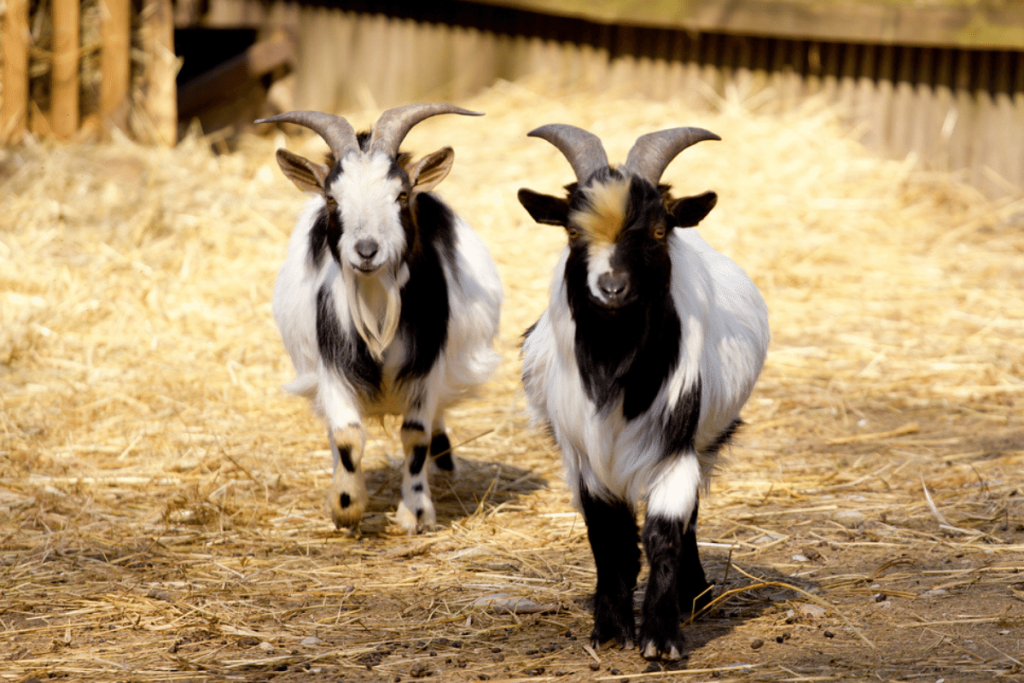If you’ve spent time around goats, you may have noticed they are well-blessed in the testicular department.
This is not random; goat reproductive behavior has created a need for large testicles in bucks.
Relative testes’ size correlates with mating behavior, and males with larger testes produce more sperm and testosterone.
The more sperm a goat produces, the more offspring it can have.
Goats produce a lot of sperm because they are herd animals. A single buck mates with many female goats and must be biologically prepared to do so at any moment. To accomplish this, they need large testicles with lots of sperm.
A buck has other characteristics goat breeders look for, such as being well-muscled, having good body weight, big, coarse shoulders, and other indications of good testosterone levels.
Scrotal circumference is directly related to sperm production.
To learn more about why goats have such large testicles, read on!

Table of Contents
ToggleWhy Goat Testicles Are So Big
One theory is larger testes are usually associated with animals where the female mates repeatedly with different males.
The male producing the most sperm has a greater chance of fertilizing the female.
Another theory is that a male who mates with several females also needs larger testes.
The male must be able to fertilize all the females in his herd and needs a lot of sperm.
Either way, for the most part, large testicles mean more sperm production and winning the reproductive race.
Do Big Testicles Mean More Sperm?
For the most part, larger testes mean more sperm in the animal kingdom.
Scientists have studied testicle size, weight, and scrotal circumference and determined each gram (g) of testicular mass produces 25 million sperm per day.
More sperm means greater reproductive success–the “outnumber to outcompete” approach.
This success will lead to offspring with larger testicles and so on.
Larger testicles also correlate with more testosterone which means more success in getting a mate in the animal kingdom.
What Do We Use Goat Testicles For?
Historically, humans have eaten all parts of an animal, letting nothing go to waste.
After goat castration, goat owners save the testicles as a delicacy.
Testicles are smoked, fried, sauced, fricasseed, baked in pies, poached, roasted, etc.
Throughout recorded history, there have been mentions of the aphrodisiac effects of eating other animals’ testicles.
The greek god of fertility, Pan, was half goat and goats are considered particularly lustful.
Although there is testosterone in goat testicles, cooking removes it, so most of the nutritional benefit is protein with likely no hormonal benefits.
While eating organ meats is healthy due to their greater nutrition content, there is no scientific evidence for any aphrodisiac effect from eating testicles.
Medical Uses for Goat Testicles
In keeping with the myth eating testicles cures impotence, a medical quack and con artist from the 1920s, John Brinkley, came up with an even more outlandish idea.
He sold a miracle cure for impotence involving sewing goat testicular glands into a patient’s scrotum.
Needless to say, this was ineffective.
The FDA does not acknowledge any particular medical benefit other than its minor nutritional benefits.
From a legitimate nutritional perspective, they are high in protein, potassium, iron, and phosphorus, making them a (supposedly) tasty, somewhat healthy food.
Why Are My Goat’s Balls Swollen?
If your intact buck’s testicles are swollen, they need to be taken care of.
Some causes of swelling in the scrotum are external injury, infection, disease, and heart failure.
The most common issues with the scrotum are on the surface and include mange, mites, frostbite, and callusing.
A duct behind the testis called the epididymis is susceptible to bacterial infection called epididymitis.
Sometimes a testicle becomes inflamed, which is called epididymo-orchitis.
Goats form calluses on their testicles from laying down in the dirt and flopping their testicles.
Another condition affecting your goat’s testicles is called unilateral cryptorchid.
This is when one or both testicles do not normally descend into the scrotum but into the body cavity.
These goats are undesirable for your flock as they will not breed properly.
Another medical concern with goats’ scrotums is when they are split, this being an undesirable characteristic because of the link to split udders in does.
Goat Development And Aging
Male goat kids are fertile at just shy of 2 months of age!
Do not breed your goats this young.
It is better to wait until they are about a year old.
Male goats reach sexual maturity between 4 and 6 months of age.
A buckling is an adolescent male goat, up to 12 months of age.
A buck, or billy, is an adult male goat; a neutered male is called a wether.
Doelings are adolescent female goats up to 12 months of age.
A doe, or nanny, is an adult female goat.
Female goats can reach puberty anywhere from 4 months to 12 months of age, depending on the breed, nutrition, and health of the doeling.
Does need to be 60-70% of their breed’s adult weight before breeding.
Breeding too young can cause birth complications, endanger the child, and hinder future reproductive capability.
Goat Reproduction
Goats typically breed in the fall through late winter.
Fertile female goats, or does, come into heat about every three weeks during this time.
Gestation is around 5 months.
A one-year-old buck will service a herd of up to ten does.
A two-year-old buck will be able to handle up to 25 does.
A three-year-old buck can service up to 40 does, depending on his drive and health!
Male goats have the highest semen quality, libido, and fertility in the late summer and fall.
A large herd does well with a buck and a wether.
How useful was this post?
Click on a star to rate it!
We are sorry that this post was not useful for you!
Let us improve this post!
Tell us how we can improve this post?
